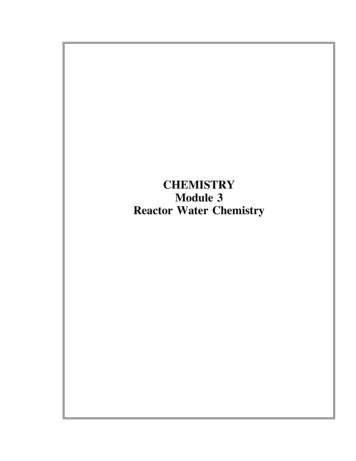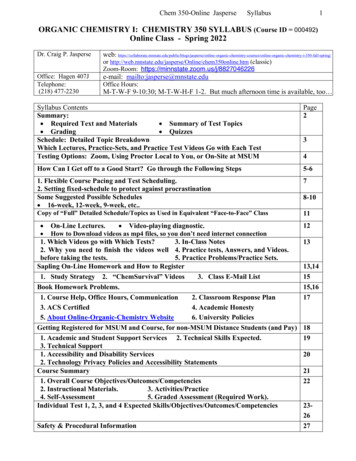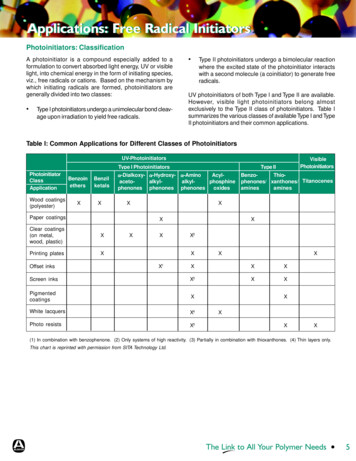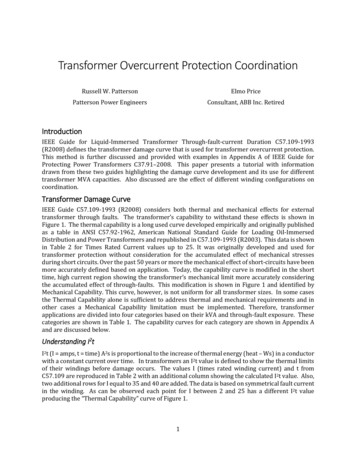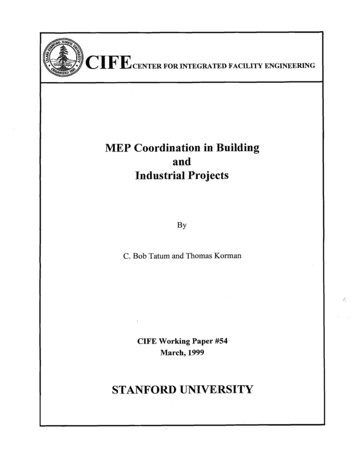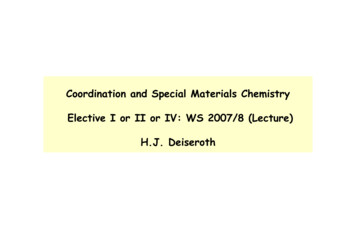
Transcription
Coordination and Special Materials ChemistryElective I or II or IV: WS 2007/8 (Lecture)H.J. Deiseroth
Coordination and special materials ChemistryRecommended Textbooks
How did the study of coordination compounds start?The coordination chemistry was pioneered by NobelPrize winner Alfred Werner (1866-1919). He receivedthe Nobel Prize in 1913 for his coordination theory oftransition metal-amine complexes.Werner studied the metal-ammine complexes such as [Co(NH3)6Cl3] andrecognized the existence of several forms of „cobalt-ammonia chloride“. Thesecompounds have different colour and other characteristics. The chemical formulahas three chloride ions per mole, but the number of chloride ions that precipitatewith Ag ions per formula is not always three. He thought only ionised chlorideions will form a precipitate with silver ions. In the following table, the numberbelow the ionised Cl- is the number of ionised chloride ions per formula. Todistinguish ionised chloride from the coordinated chloride, Werner formulated theComplex formula and explained the structure of the cobalt complexes.
How did the study of coordination compounds start?Proposed Structures of Cobalt Ammine Complexes from the Number ofIonized Chloride ionsCoCl3 6NH3:Yellow [Co(NH3)6]Cl3CoCl3 5NH3 Purple[Co(NH3)5Cl]Cl2CoCl3 4NH3 Green trans-[Co(NH3)4Cl2]ClCoCl3 4NH3 Violet cis-[Co(NH3)4Cl2]ClThe structures of the complexes were proposed based on a coordinationsphere of 6. The 6 ligands can be ammonia molecules or chloride ions. Twodifferent structures were proposed for the last two compounds, the transcompound has two chloride ions on opposite vertices of an octahedron,whereas the two chloride ions are adjacent to each other in the ciscompound. The cis and trans compounds are known as geometric isomers.Isomerism is a very common feature of coordination compounds and will bediscussed in more detail later.
Coordination and special materials ChemistryCoordination chemistry is the chemistry of compounds formed between metalatoms/ions and other neutral or negatively charged moleculescomplex compoundsligand (donorgroup) coordination compounds.central atomcoordinationnumber (CN 6)Hexa-methyl-zirconate (IV)(CH3)- (!)Isomers: Compounds with the same chemical formula but different structures.Different types of isomerism: linkage isomerism, hydrate isomerism, cis-transisomerism, coordination isomerism etc. (see seminar talk)
Naming of coordination compounds- The names of complexes start with the ligands (in alphabetical order), theanionic ones first , followed by neutral ligands, the central atom and theoxidation state (Roman numerals).- If the complex is negative, the name ends with "ate".- names of anionic ligands end with „o“ : chloro-, oxo-, fluoro-, cyano.- neutral ones without specific ending: (exception: H2O: aqua, NH3: ammine)C5H5N, pyridine, NH2CH2CH2NH2, ethylenediamine, C5H4N-C5H4N, dipyridyl,P(C6H5)3: triphenylphosphine, CO: carbonyl, CS: thiocarbonyl,[Co(NH3)5Cl]Cl2: 2]Cl: kis(phosphorus-tri-fluoride)-nickel(0)simple ligands: di- tri-, tetra-, penta-, hexa- .complex ligands: bis-, tris-, tetrakis- .
Symmetry Elements, Symmetry Operations, Point Groups
Coordination compounds with CN 2 (linear)CN 2 is very common for complex ions and molecules ofCu(I), Au(I), Ag(I) and Hg(II)CN 3 is very rare among normal coordination compounds of d-metals
Coordination compounds with CN 4 (tetrahedral)
Coordination compounds with CN 4 (square planar)Preferred coordination of d8 central atoms !!
Coordination compounds with CN 5 (Square pyramidal)(e.g. active center of myoglobin and haemoglobin)Imidazol
Coordination compounds with CN 5 (trigonal bipyramidal)
Pseudorotation (CN 5): square pyramidal trigonal pyramidal
Coordination compounds with CN 6 (octahedralal)Types of distortions of octahedra
Coordination compounds with CN 6 (trigonal prismatic)
Constitution and Coordination Number, higher CN‘sThe most important factors that determine the constitution andcoordination number of a complex are:- size of the central atom- steric interactions between ligands- electronic interactionsHigher coordination numbers (CN‘s) are favoured:- in complexes with atoms (and ions) of the periods 5 and 6- on the left of a row of the d-block where atoms are relatively large and havea small number of d-electrons- for central atoms with a high oxidation number and thus a mall number ofremaining d-electrons (e.g. [Mo(CN)8]4-
Coordination compounds with CN 7 („capped“)- rare with 3d elements but more common with 4d and 5d metalsCN 7: pentagonal bipyramid, (mono-) capped trigonal prism, capped octahedrone.g. [ZrF7]3-, [ReOCl6]2-, [UO2(OH2)5]2 .
Coordination compounds with CN 8CN 8:square antiprism („archimedian“ antiprism), trigonal dodecahedron, cube
Coordination compounds with CN 9 („capped trigonal prism“)CN 9: common with Re (e.g. [ReH9]2-) and f-block elements (e.g. [Nd(OH2)9]3 )CN 9: important only for complexes with heavy metal central atoms(e.g. f-elements)
Exercises1 Preferably without using reference material, write out the 3d elements in theirarrangement in the periodic table. lndicate the metal ions that commonly form tetrahedralcomplexes of formula [MX4]2- where X is a halide ion.2 (a) On a chart of the d-block elements in their periodic table arrangement, identify theelements and associated oxidation numbers that form square-planar complexes. (b) Giveformulas for three examples of square-planar complexes.3 (a) Sketch the two structures that describe most six-coordinate complexes. (b) Whichone of these is rare? (c) Give formulas for three different d-metal complexes that havethe more common six-coordinate structure.4 Name and draw structures of the following complexes: (a) [Ni(CO)4]; (b) [Ni(CN)4)2- (c)[CoCl4]2- (d) [Ni(NH3)6]2 .5 Draw the structures of representative complexes that contain the ligands (a) en, (b) ox2, (c) phen, and (d) edta46 Draw the structure of (a) a typical square-planar four-coordinate complex; (b) a typicaltrigonal prismatic six-coordinate complex; (c) a typical complex of coordination number 2.Name each complex.7 Give formulas for (a) pentaamminechlorocobalt(lll) chloride, (b) hexaaquairon(3 )nitrate; (c) cis-dichlorobis(ethylenediamine)ruthenium(ll); (d) μhydroxobis[pentaamminechromium(lll)] chloride.
Isomerism: cis-trans isomerismmer: meridionalfac: facial
Isomerism and Chirality (important terms)- A chiral molecule is not superimposable on its own mirror image- Optical isomerism: Rotation of the plane of polarized light shown by opticalisomers- Enantiomeric pair (“racemate”): Two mirror-image isomers in one sample- Diastereomers: Molecules with more than one center of chirality (e.g.organic sugar molecules)Criteria for absence of chirality: 1. mirror plane through central atom (S1), 2. inversioncentre (S2), 3. no improper rotationS4
Isomerism and Chirality
Exercises8 Name the octahedral complex ions (a) cis-[CrCl2(NH3)4] , (b) trans-[Cr(NCS)4(NH3)2]-, and (c)[Co(C204)(en)2) . Is the oxalato complex cis or trans?9 Draw all possible isomers of (a) octahedral [RuCl2(NH3)4], (b) square-planar [lrH(CO)(PR3)2], (c)tetrahedral [CoCl3(0H2)]-, (d) octahedral [lrCl3(PEt3)3], and (c) octahedral [CoCl2(en)(NH3)2] .10 The compound Na2lrCl5 reacts with triphenylphosphine in diethylene glycol under an atmosphereof CO to give trans-[lrCl(CO)(PPh3)2], known as Vaska's compound. Excess CO produces a fivecoordinate species and treatment with NaBH4 in ethanol gives [lrH(CO)2(PPh3)2]. Draw and namethe three complexes.11 Which of the following complexes are chiral? (a) [Cr(ox)3]3-, (b) cis-[PtCl2(en)],(c} cis2 (RhCl2(NH3)4] , (d) [Ru(bipy)3] , (e) [Co(edta)] , (f) fac-[Co(N02)3(dien)], (g) mer-[Co(N02)3(dien)I.Draw the enantiomers of the complexes identified as chiral and identify the plane of symmetry inthe structures of the achiral complexes.12 One pink solid has the formula CoCl3 5NH3 H2O. A solution of this salt is also pink and rapidlygives 3 mol AgCI on titration with silver nitrate solution. When the pink solid is heated, it loses 1mol H20 to give a purple solid with the same ratio at NH3:Cl:Co. The purple solid releases two of itschlorides rapidly; then, on dissolution and after titration with AgNO3, releases one of its chloridesslowly. Deduce the structures of the two octahedral complexes and draw and name them.13 The hydrated chromium chloride that is available commercially has the overall composition CrCl36H2O. On boiling a solution, it becomes violet and has a molar electrical conductivity similar to thatof [Co(NH3)6]Cl3. In contrast, CrCl3.5H20 is green and has a lower molar conductivity in solution. Ifa dilute acidified solution of the green complex is allowed to stand for several hours, it turns violetInterpret these observations with structural diagrams.
Basic Crystal Field Theory: tetrahedral and octahedral fieldAllatoms/moleculesare treated aselectrical pointchargest2eget2g
Basic Crystal Field Theory: splitting of energy levels(spectrochemical series)The influence of different ligands on the size of Δ 10DqIncreasing strength of the ligand field I- S2- Cl- NO3- F- H2O NH3 en NO2- CN- COThe strength of the ligand field varies with:a) the size and chemical properties of the ligand (no simplerelation !)b) the oxidation number of the central atom (the higher theoxidation number the stronger the ligand field)
Basic Crystal Field Theory: optical spectrum and ligand field 500 nm (red) – absorption in the blue green region, complex has complementary color20300 cm-1 Δo Δo[Ti(H2O)6]3 Ti3 : (Ar)d1, octahedral complex
Basic Crystal Field Theory: Weak Field – Strong FieldSpin pairing energy versus ligand field splittingoctahedral complexweak fieldd6 high spin(paramagnetism)high spin:low spin:strong fieldd6 low spin(diamagnetism)maximum number of unpaired electronsminimum number of unpaired electrons tetrahedral: high spin (preferably)octahedral: low spin (preferably)
Basic Crystal Field Theory: Ligand field stabilization energies(LFSE)LFSE: Energetic stabilization relative toa field with spherical symmetryTetrahedralt2Tetrahedral case:LFSE (-0.6 x(e) 0.4 y(t2)) ΔTOctahedral case:LFSE (-0.4 x(t2g) 0.6 y(eg)) ΔOOctahedralegx, y: number of electrons in the respectiveelectronic states (eg or t2g)et2g
Basic Crystal Field Theory: Ligand field stabilization energies(LFSE)
Basic Crystal Field Theory: Ligand field stabilization energies(LFSE) – Ionic radiilow spinhigh spin
Basic Crystal Field Theory: Ligand field stabilization energies(LFSE) – Hydration enthalpy of M2 ionsYellow points: after subtraction of LFSE from experimental valueHydration enthalpy of M2
Magnetism of coordination compounds: magnetic (dipole) momentsIn general there are two components of the resulting magnetic moment of an atom (ion): orbital angular momentum (μO) spin momentum (μS)- In most coordination compounds with 3d elements as central atoms the orbital angularmomentum can be neglected (technical term: “quenched”).- typical for 3d complexes with one central atom: spin only magnetism (μS)Definition of μS:μS μB 2 (S(S 1))1/2μOμSμB 9,27 10-24 Am2 (Bohr magneton,smallest quantity of a magnetic moment)S ½ n (Total spin quantum numbern: number of unpaired electrons)μS
Magnetism of coordination compounds: tral atom with unpaired valenceelectrons paramagnetismcentral atom with paired valence electronsonly diamagnetism
Magnetism of coordination compounds: SQUIDSQUID: Superconducting Quantum Interference DevicecoilSophisticated physical background based onthe quantization of magnetic flux (one ortwo weak links, „Josephson contacts“) in asuperconducting wire (loop) that allow thetunneling of „Cooper pairs“.
Special aspects of the electronic structure of complexes with CN 41. Tetrahedral coordination- inverse splitting (compared tooctahedral case)- only the weak field case is ofimportance ( high spin magnetism)2. Tetragonal and square planar coordination (Jahn-Teller-effect)
Special aspects of the electronic structure of complexes with CN 4Ni2 , Pd2 , Pt2 , Rh .d4dynamic Jahn-Teller effecttemperature drivenintramolecular change of theelongation directiond9d7d8square planartetragonally elongated
Exercises1.2.3.Determine the configuration (in the form t2gx egy or ex ty, as appropiate), the number ofunpaired electrons and the ligand field stabilization energy (LFSE) as a multiple of Δoct or Δtetfor each of the following complexes: [Co(NH3)6]3 , [Fe(H2O)6]2 , [Fe(CN)6]3-, [W(CO)6] and[FeCl4]2-. Estimate the spin only contribution to the magnetic moment in each complex.Solutions of the complexes [Co(NH3)6]2 , [Co(H2O)6]2 (both Oh) and [CoCl4]2- (Td) are colored.One is pink, another yellow and the third is blue. Considering the spectrochemical series andthe relative magnitudes of Δtet and Δoct assign each color to one of the complexes.For each of the following pairs of complexes identify the one that has the larger LFSE:[Cr(H2O)6]2 - [Mn(H2O)6]2 [Mn(H2O)6]2 - [Fe(H2O)6]3 [Fe(H2O)6]3 - [Fe(CN)6]3-4.Estimate the spin only contribution to the magnet moments for each of the complexes in 1.
Ligand-field theoryCrystal field theory has problems to explain why the ligand field splitting for someuncharged molecules (e.g. CO) is unusually large and is moderate for others (e.g. NH3).CFT is unable to explain spectra of more complex coordination compounds. solution: the interaction between ligands and central
Prize winner Alfred Werner (1866-1919). He received the Nobel Prize in 1913 for his coordination theory of transition metal-amine complexes. Werner studied the metal-ammine complexes such as [Co(NH 3) 6Cl 3] and recognized the existence of several forms of „cobalt-ammonia chloride“. These compounds have different colour and other characteristics. The chemical formula has three chloride .

